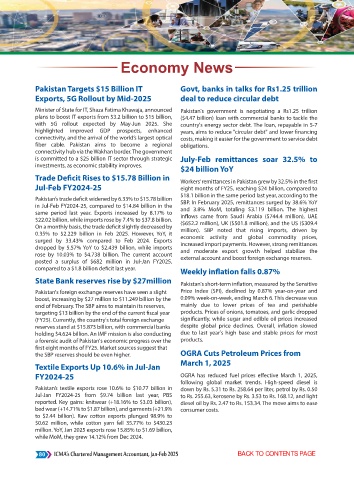Page 82 - CMA Journal (July-August 2025)
P. 82
S B
Strategic SWOT Overview of Digital
Payment and E-Commerce Sector
The following provides a brief overview of the sector using the
SWOT framework and does not represent a detailed analysis
STRENGTHS WEAKNESSES
Pakistan’s digital payments reached 2 billion transactions Persistent cash reliance hinders digital payments, limits
accounting for 89% of total retail payments during the Q3 of FY25. e-commerce growth, sustains informality, while delayed
Pakistan achieved Tier 1 status in the ITU Global Cybersecurity RAAST merchant payment features compound challenges.
Index, climbing from 79th to the top 46th position globally. Card-based payments remain a minor share of e-commerce
Mobile banking, the fastest-growing channel, processed compared to cash transfers, e-wallets and mobile banking.
1,686 million transactions worth Rs. 27 trillion in Q3 FY25, E-commerce volumes fell 40% YoY despite merchant growth.
reflecting 16% growth in volume and a 22% surge in value. Digital divide persists, with limited internet penetration in
Internet banking throughput grew 58.6% YoY, with high-value rural areas.
transactions averaging Rs. 84.9k. Weak logistics networks hinder last-mile delivery efficiency.
POS network expanded to over 132,000 devices, boosting Inconsistent enforcement of e-commerce and digital
acceptance infrastructure. transaction laws.
RAAST processed 371 million transactions worth Rs. 8.5 trillion Low financial inclusion and digital literacy restricts uptake.
in Q3 FY25. SME reluctance due to onboarding complexity and
Branchless banking wallets reached 64.3 million users, driving compliance costs.
transaction growth. Limited capacity of regulators to monitor fintechs and
Youth-heavy population (64% under 30) fuels rapid digital venture capital.
adoption. Exclusion of informal, OTC, and branchless data limits overall
E-commerce transaction value grew 29–30% in Q2 FY2025 market visibility.
despite volume shifts. Fragmented inter-agency coordination slows digital policy
JazzCash boasts 48 million registered users, 350,000 merchants, execution.
and an annual value equal to 9% of GDP. Digital banks struggle with high startup costs, delayed
Daraz leads e-commerce with US$857 million GMV and profitability, entrenched bank competition, and weak dispute
34,500 sellers. resolution.
Entry of Mashreq as Pakistan’s first SBP-approved digital retail Regulatory uncertainty, particularly around taxation, deters
bank shows regulatory openness. investors.
SadaPay’s acquisition by Papara validates fintech market Lack of standardized brokerage and payment integration
attractiveness. software.
E-commerce revenues reached US$504 million in July 2025, up Over-reliance on bank-led innovation, with fintechs still
5–10% from June. small-scale.
National E-Commerce Policy (2025–2030) prioritizes QR code
standardization and logistics upgrades.
S W
SWOT
H
T
T
A
E
R
S
P
T
U
OPPORTUNITIESS O T THREATS
I
I
O
E
N
T
P
O
R
Doubling of e-commerce users from 6.9 million in 2024 to B an k i ng g c o
to
Banking complaints surged to 16,915 in H1-2025, straining
14 million by 2029. consumer
consumer trust.
Projected digital commerce market growth to US$32.94 billion n Cybersecurity risks, including phishing and AI fraud, persist.
by 2030. Weak logistics contribute to congestion and environmental
Digital payments market projected to reach US$92.83 billion issues.
by 2030. Fragmented tax system complicates compliance for SMEs.
Centralized KYC/AML onboarding could reduce duplication and d Resistance from legacy banking models could slow fintech entry.
speed adoption. Gaps in digital ID verification hinder onboarding, especially for
Expanding QR code and pull-payment use cases via Raast. women.
Integration of SECP, FBR, NADRA, and provincial data for seamless Weak payment dispute resolution discourages daily users.
ess
seller onboarding.
Growing EMI penetration, led by brands like SadaPay Global e-commerce giants pose competitive pressure on local
platforms.
and Nayapay.
Public procurement adoption of digital payments can set Macroeconomic instability may limit fintech scaling, particularly
in lending.
industry precedent.
IFMP-led training reforms to professionalize digital Merchant discount rate changes could slow POS growth.
New tiered transaction taxes may dampen e-commerce and
finance workforce.
payment adoption.
Expansion of Mashreq and other digital banks could diversify Over 500,000 gig workers remain outside social protection
competition.
schemes.
National Financial Inclusion Strategy (NFIS) 2024–28 will drive Regulatory bottlenecks delay digital banking licenses.
digital microfinance, boosts liquidity, and would reduce Inadequate cross-border payment frameworks for
operating costs. exporters/importers.
Rising mobile internet coverage unlocking rural markets. Consumer shift back to cash-on-delivery in times of uncertainty.
E-commerce CAGR forecast at 17% in 2027.
Emergence of fintech-led merchant credit innovation for SMEs.
Potential cross-border B2B platforms like Shoplus for
export growth.
u
202
g
d
M
g
ana
s
CMA’
artere
Ch
u
J
l
A
-
ement
A
,
ccountant
800 I ICMA’s Chartered Management Accountant, Jul-Aug 20255
8

